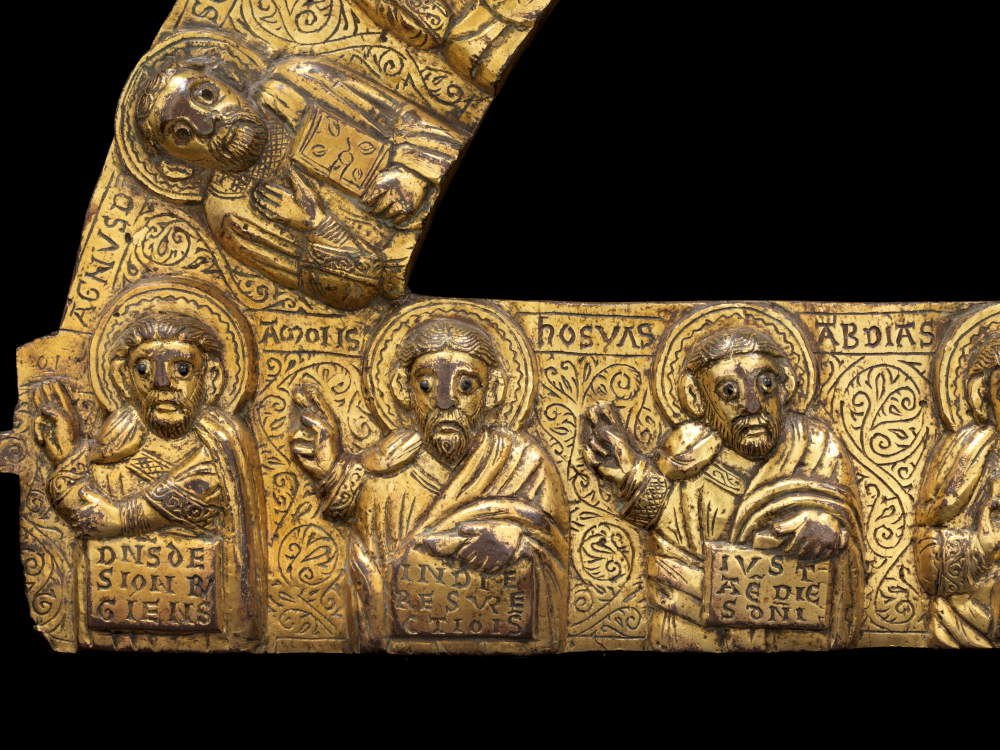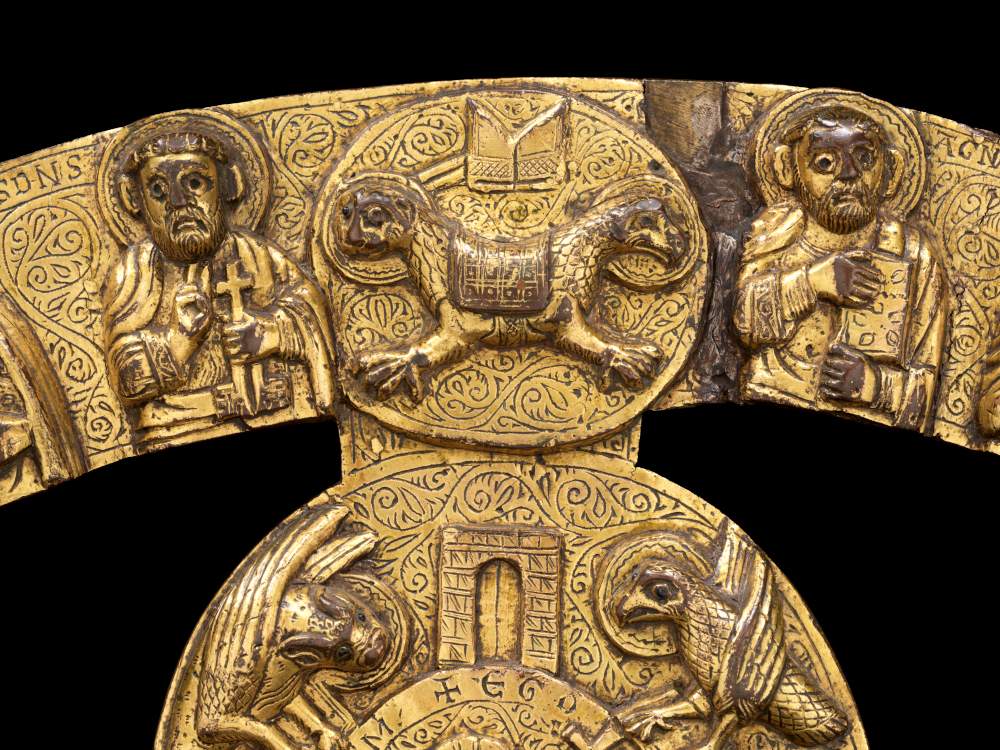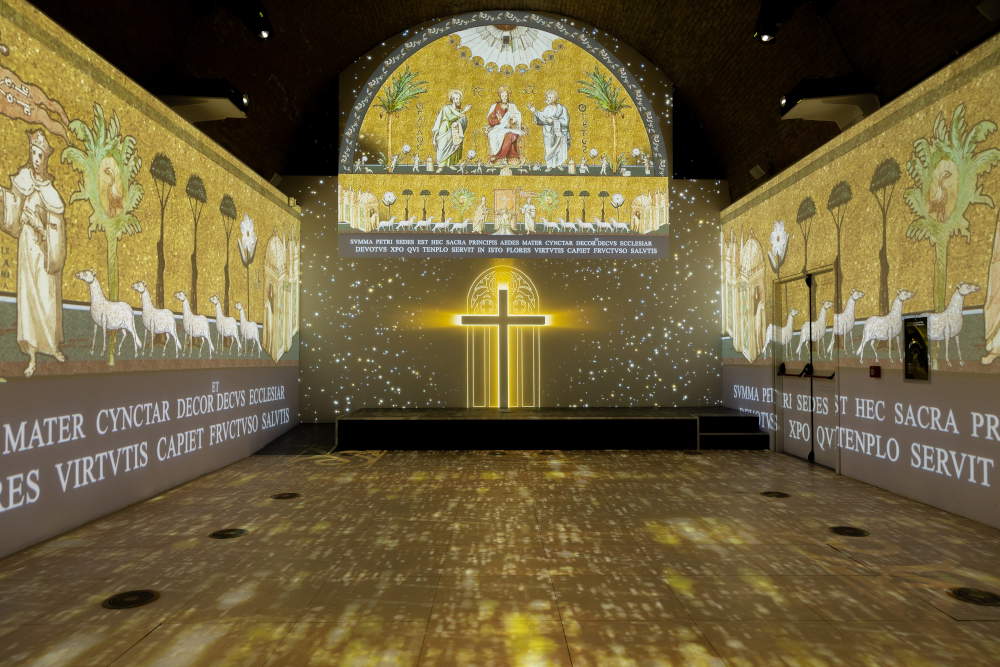As part of a series of exhibition projects desired and conceived by the director of the VIVE - Vittoriano and Palazzo Venezia Edith Gabrielli in order to enhance and acquaint a wider audience with the collections of Palazzo Venezia and the Vittoriano, the exhibition Bronzo&Oro. Rome, Pope Innocent III: An Immersive Tale of a Masterpiece, curated by Alessandro Tomei, former professor of Medieval Art History at the University of Chieti and a scholar of central Italian painting of the 13th and 14th centuries, the miniature and the suntuary arts. The coordination of the exhibition and the catalog are edited by Skira.
The star of the exhibition is the Lunetta della Nicchia dei Palli, among the most precious pieces in the Palazzo Venezia collections and the subject of restoration, study and research for the occasion. It is an artifact of medieval goldsmithing in gilded bronze, which originally, according to some scholars, was probably intended for the Constantinian basilica of St. Peter’s in the Vatican, that is, placed at the crowning of the so-called Niche of the Pal li used to place there precisely the white stoles quilted with black crosses that pontiffs still hand over to bishops during the solemn ceremony of vesting and then located in the Confession of the ancient basilica, below the high altar. Having survived the demolition of the primitive basilica, the lunette was preserved for a long time in the Sanctuary of Santa Maria delle Grazie in Venturella (Mentorella) in Capranica Prenestina and in the second half of the last century was deposited in the museum of Palazzo Venezia where it is still located today.
The artifact dates back to the first decade of the 13th century, to the time of the pontificate of Innocent III, born Lothair of the Counts of Segni, which lasted from 1198 to 1216; for this reason it is considered the most important surviving work of art connected to the figure of Pope Innocent III. The pontiff decided to renovate the apsidal mosaic of St. Peter’s Basilica in the Vatican, whose iconography centered on the concept of the supremacy and power of the Church of Rome, directly descended from Christ, and this renovation project also included the creation of decorative elements of the interior of the basilica, of which the lunette was a part. The mosaic no longer exists today because of the work that between the 16th and 17th centuries led to the destruction of the ancient Constantinian factory and the construction of the present building. However, only three fragments remain: one depicting the portrait of Pope Innocent III, one with a phoenix within a clypeus, both preserved in the Museum of Rome, and a third with the image of the Ecclesia romana, also preserved in Rome, in the Giovanni Barracco Museum of Ancient Sculpture.
According to a hypothesis arrived at in the course of its cataloguing, the lunette would have been made by Limoges craftsmen who moved on purpose along the banks of the Tiber, further helping to qualify Rome as an artistic melting pot with a European scope; influences from the Rhine and Meuse areas are also recognizable.
“The lunette constitutes valuable evidence of the lost decoration of medieval St. Peter’s. In the course of the rebuilding of the basilica in the Renaissance period, the immense wealth of works of art that for more than a millennium had been commissioned by popes, cardinals, kings, and princes to make the place dedicated to the saint more and more sumptuous,” the curator says. “Partial memory of them remains in graphic and written sources and, in the unfolding of the works, few fragments of those works were saved, sometimes being transferred to the Vatican Grottoes, sometimes acquired by prelates who transferred them, for preservation, to family churches, even outside Rome.”




The lunette features work on both sides: on the recto the foil shows in relief twelve prophets and the twelve apostles and, in the center, Christ as Agnus Dei and other symbols taken from the Book of Revelation. On the verso, on the other hand, figures of bishops within arches on columns and the depiction of a pontiff and the Holy Spirit in the form of a dove are seen executed in engraving.
As already mentioned, the lunette is linked to the period of the pontificate of Innocent III, so the Bronzo&Oro exhibition intends to reconstruct and narrate, through the precious artifact, the figure of the pontiff; the exhibition also wants to make people better understand the layout of the ancient basilica of St. Peter’s, for the occasion restored through immersive reality. The aim of the exhibition is also to succeed in involving a wider audience to bring it closer to a complex and difficult-to-imagine moment in art history. Through a rich iconographic and informative apparatus, it is intended to introduce visitors to the masterpiece of medieval goldsmithing, contextualizing the historical and art historical period. With the help of an installation, created using modern 3D digital modeling and virtual reality technologies, St. Peter’s Basilica at the time of Innocent III materializes on the walls and floor of the new immersive hall. Visitors will find themselves catapulted inside the medieval basilica reconstructed through the study of ancient iconographic sources and descriptions of the time. The Lunette of the Niche of the Palli will appear on the walls of the room: very high-resolution images will show all the details, hardly visible to the naked eye, such as the Agnus Dei, the door of God, the prophets, the apostles and the image of the pontiff, accompanied by 3D sounds and animations.
The exhibition is accompanied by the volume Bronzo&Oro. Rome, Pope Innocent III: Tale of a Masterpiece, published by Skira with texts by Gaetano Curzi, Giampaolo Distefano, Edith Gabrielli, Christian Grasso, Almuth Klein, Paolo Liverani, Alessandro Tomei and Vittorio Lanzani.
For information and guided tours: vive.cultura.gov.it
Hours: Daily from 9:30 a.m. to 7:30 p.m. (last admission at 6:45 p.m.).
Free admission.


 |
| A precious artifact of medieval goldsmithing and the link with Innocent III: an exhibition at the Vittoriano |
Warning: the translation into English of the original Italian article was created using automatic tools. We undertake to review all articles, but we do not guarantee the total absence of inaccuracies in the translation due to the program. You can find the original by clicking on the ITA button. If you find any mistake,please contact us.